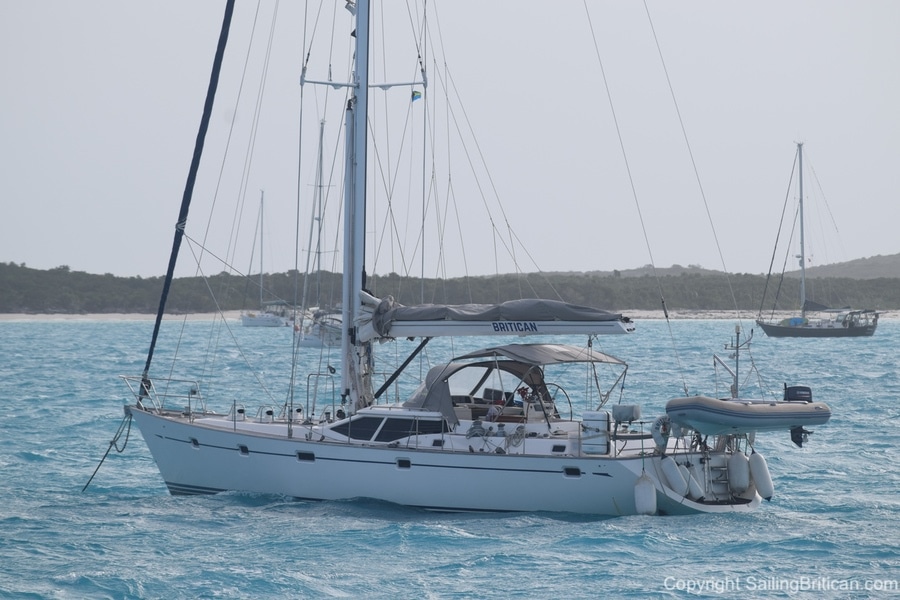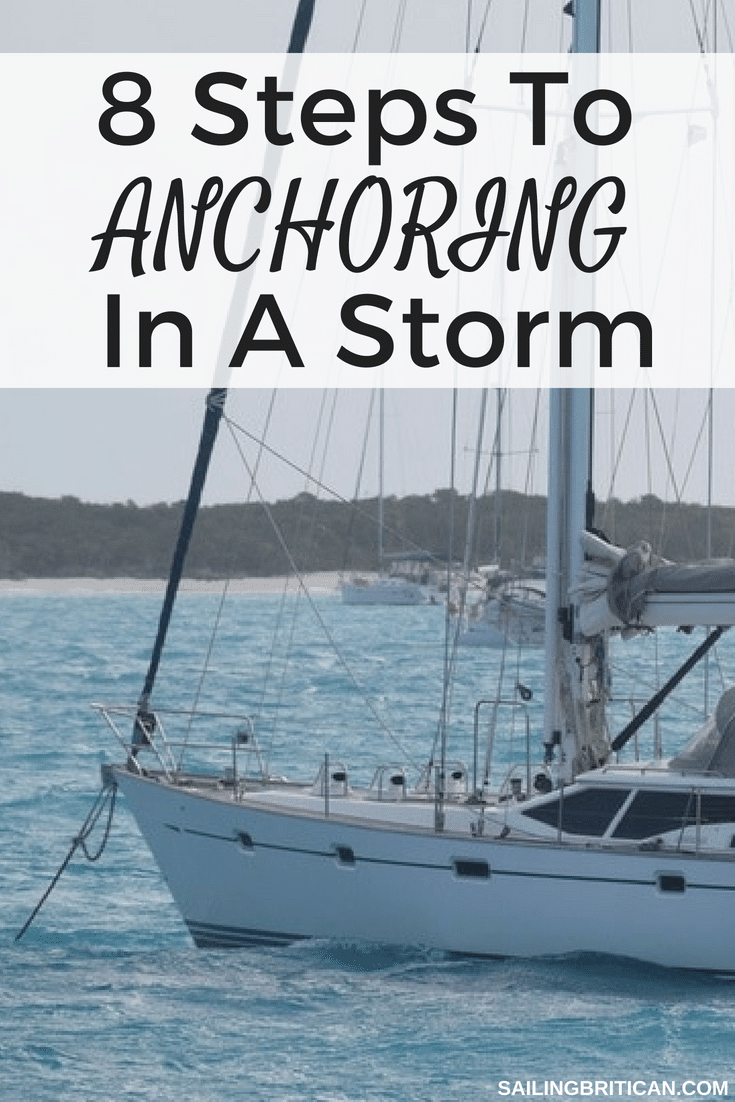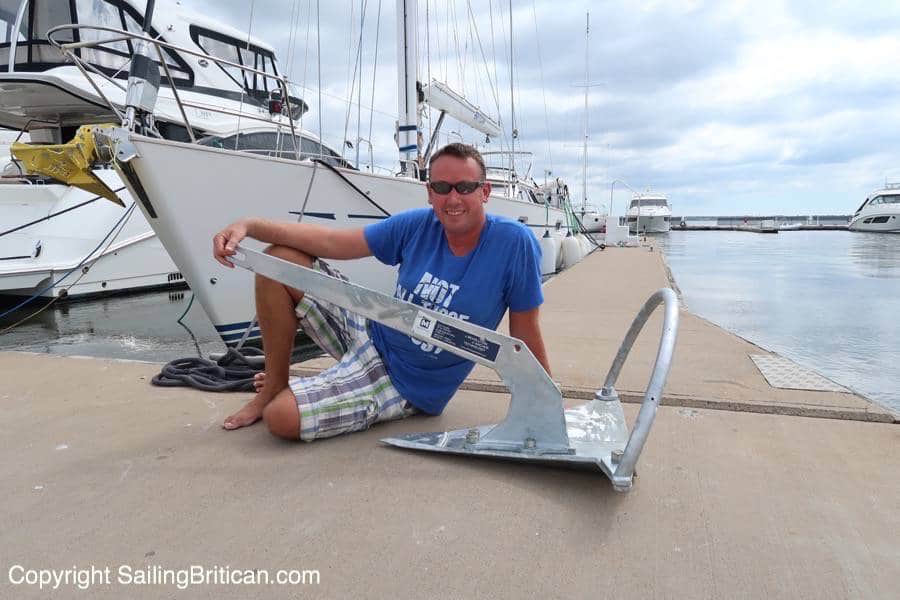So, what do you do if a storm is on its way and you’re anchored in a harbor? Anchoring in a storm or high winds is part of the sailing lifestyle. Many storms arrive unannounced, and others, although predicted, can be worse than expected.
Use these eight steps to anchoring in a storm. As a sailor, it's important to understand key steps to ensure your boat and crew are safe. Click To TweetAfter reading the steps, watch our video, located below, showcasing A Big Blow in The Bahamas.
For three days we were anchoring in a storm with winds of up to 45 knots and gusts well over 50 knots. The video also shows a catamaran dragging and important information about how we handled the high winds.

8 Steps To Anchoring In A Storm
1. Analyze your surroundings
Survey your current anchor spot and determine if it makes sense to move the boat to another safer anchorage or another spot within the anchorage. There are many factors to consider when analyzing the safety of a harbor, especially when a storm is on its way.
Ideally, when it hits, you want the wind to blow you away from land and/or any obstructions (rocks, shallows, etc.) in addition to having good holding for your anchor. Look at the forecasts to determine if the wind direction will change and if you can safely swing on your anchor.
Another key consideration regarding anchoring in a storm is the number of boats in the anchorage.
With more boats, there are more chances of another boat dragging and hitting you. There’s also the position within the anchorage to consider. If you anchor close to shore and drag, how many boats will you take out on your way? Or what happens if you get your anchor line fouled in another line?
TIP: We usually anchor the furthest away from land and other boaters in a harbor. We feel that if things get really bad, our best bet is to up anchor and head out into sea away from other boats, land, etc. The downside of doing so is that the wind can often be stronger as there’s less protection from the land.
2. Dive on your anchor.
Wherever you decide to anchor, if it’s possible, make sure to dive down to visually ensure that it’s bedded in. Later, when the storm hits this action will provide a higher degree of comfort. In many cases, it’s impossible to do a visual inspection, but if you could have done it and didn’t, you’ll regret it when the winds start blowing.
When diving, make sure that the anchor is set well. Also, take note of the seabed. If you’ve anchored in the grass or around grass, you might want to switch to an alternative anchorage. When dragging in the grass the anchor often gets filled with grass and mud preventing the anchor from resetting.
Important note: Many sailors fail to understand the art of anchoring. I think that people assume it’s easy or that it’s just one of those things that come naturally?! If you have any doubt about your knowledge of anchoring and/or whether or not your ground tackle is correct for your boat, this is one aspect where ignorance is not bliss.
Get my step-by-step checklist on anchoring in my guide, Checklists for Sailors. Not only will it decrease your likelihood of dragging, but it will also provide you with increased peace of mind that you prepared properly.
Checklists for Sailors
If you’re a sailing enthusiast eager to enhance your sailing experience, this publication is an indispensable guide that will revolutionize how you approach your maritime adventures. This experienced-based guide is tailored to cater to sailors of all skill levels, providing comprehensive checklists that cover every aspect of sailing preparation and execution. From pre-departure rituals to navigation essentials, anchoring & mooring balls, safety protocols, and emergency procedures, this guide ensures you navigate the seas confidently and precisely. Checklists for Sailors serve as a valuable tool for seasoned sailors to reinforce their routines and an invaluable resource for novices seeking to learn the ropes of sailing seamlessly. Invest in this guide, and embark on your sailing journeys with the assurance that you are well-prepared for every nautical challenge that comes your way. Get Checklists for Sailors here!
3. Let out enough scope when anchoring in a storm
If you’re happy with your current location and you’ve done your best to verify that the anchor is well set, the next step is to consider your scope. The scope is the ratio of anchor rode (anchor chain or rope) let out according to the depth of water you’re in, considering your freeboard (length from the deck to the waterline). Most sailors use a ratio of around 3 to 5 times the depth in calm weather. So, if you’re in 15’ of water (including freeboard), you’ll let out 75’ of rode using the 5x ratio.
When you originally anchored, if your scope was between 3x to 5x the depth, you’ll want to increase that figure. Many sailors will aim for a 7x to 8x scope during storm situations if doing so does not put the boat in danger. The key concept is that more rode causes more of a horizontal pull on an anchor, and less rode causes a vertical pull.
During a storm, the wind causes the anchor rode to pull back, and waves cause it to jostle up and down. The more rode that’s out, the less likely that it will pull up and out.
And if the anchor does pull out, with more rode, you’ll have better chances for it to drag rather than get pulled through the water. In other words, if the anchor drags, it’s more likely to reset itself, provided enough scope is used.
However, it’s important to note that too much scope is not necessarily good either.
Too much rode can put you dangerously close to obstructions. Furthermore, in really high winds, your boat can start to sail. We’ve seen boats sail right off the anchor due to too much rode out!
In short, before a storm hits, ensure that you have a scope that is suitable.
4. Ensure you have a snubber, or bridle, attached with anti-chafing guards.
If you don’t have a snubber or bridle and plan on anchoring your boat often, you’ll need to put that on your shopping list as a number one priority. Time after time, I see boats without snubbers and can’t believe my eyes.
A snubber takes the load of the ground tackle, wind, and current off the windless mechanism (the thing that pulls the chain in and out) and places it onto the hull, or superstructure, of the boat.
The windlass is just a tiny bit of kit. You wouldn’t want something so small to hold the boat’s weight, would you? Using a snubber, you effectively create a small bit of slack in the anchor chain, removing any pressure on the windless. The load is then transferred onto strong points on the boat’s hull.
Again, if you’re not accustomed to using a snubber, get my anchoring guide, as it’s vital equipment. Within the guide, I offer information on how to use a snubber.
Get Checklists for Sailors for a full checklist on how to anchor!
Additionally, when anchoring in a storm, the snubber can move about over the top of the anchor chainplate. There’s a high chance of chafing, so using anti-chaffing guards is vital. If you don’t have chafe guards, you can wrap areas of the snubber with heavy-duty tape.
5. Check that your anchor alarm is set
Use a couple of anchor alarm systems to ensure you’re covered. We use our built-in GPS anchor alarm system and an Ipad anchor alarm app (We use SafeAnchor.net). When our alarm goes off, we know it’s time to act.
Anchor alarms allow you to program the position of your anchor and then set the radius you’re happy to swing within. If the boat goes outside the circle’s circumference, the alarm will trigger.
In 99.9% of the cases, our alarms are triggered due to naturally swinging outside the limits we set, but it’s better to be safe than sorry. If you’re dragging, you want to know as soon as possible.
6. Reduce the amount of windage on your boat
Before the storm hits, remove anything that will catch the wind and increase the load on the anchor tackle. Pull down your sprayhood, bimini, cockpit enclosures, and so forth. Not only will this protect them from tears or blowing off, but it will also provide your anchor with a higher chance of holding.
7. Decide upon an anchor watch system
When anchoring in a storm, if it’s going to blow and you’re in a crowded harbor, it might be worth setting a watch rotation. We often do three hours on and off all night, similar to our night sailing watches. On an anchor watch, you’re ready to respond in the case of dragging, and, often, more importantly, you can see an oncoming boat dragging towards you. We’ve had many boats drag in front of us and behind us, and a few have even hit us. Luckily, we were always on sight to use fenders to fend the boat off or work with the other boat owner to find a solution.
8. Have anchor faith
If you have loads of time before a storm hits (perhaps you’re reading this before you’ve even purchased a boat?!), my biggest advice is to understand your anchor system. Find out how your anchor ranks in the world of best-setting anchors for the seabed you plan on anchoring in. Research the areas you plan to anchor and ensure you have enough rode or chains.
Side story: Our good friends purchased a boat and set sail for the Bahamas. By the time they got to Georgetown, they had anchored a couple of times and had already realized their anchor was inadequate. Having a Bruce anchor, they dragged time and time again. When The Big Blow of 2018 hit, they had three sleepless nights. Thankfully, they didn’t drag during the high winds, but they did drag at other times. As soon as they reached Puerto Rico, where they could source a new anchor, they purchased a Rocna.
Nothing is worse than being stuck on a boat in high winds for 48 or 60 hours, not having anchor faith. To reduce fear and be able to sleep at night, you want to know that you have an anchor that will keep you safe.
And if you don’t already have a Mantus Anchor or a similar new breed of more advanced anchors, do yourself a favor and get one. Whenever I freak out, my husband looks at me and says, ‘Kim, we have the best anchor in the world. We have a Mantus.’
Sailing and the sailing lifestyle are most exciting, enjoyable, and fulfilling.
However, some bits and pieces suck. And I mean, suck. Being at anchor in a storm or a hurricane is scary. If you’re going to be a boater, storms happen. When a storm hits, you want to know that you’ve done the best you can.
Out of the millions of things a boat owner can purchase, it can be confusing as to what’s a necessity versus what’s nice. Having a plotter that provides a touch screen or a new-fangled techy gadget is not a necessity! Having a sound ground tackle system is.
We’ve come across loads of boats with all sorts of bells and whistles, and then you look at the anchor and notice that it’s an old-generation anchor (like a Bruce, Delta, or CQR). What the heck?! Priorities people. Priorities.
But sailing, sailboats, and the sailing lifestyle are overwhelming to newcomers. I’ve done this full-time for six years and still consider myself wet behind the ears. We don’t know what we don’t know.
Living Aboard A Boat Video – Featuring The Big Blow of The Bahamas (Anchoring in A Storm)
Enjoy more Bahamas articles and episodes
Check out all our Bahamas articles and videos here: Sailing Bahamas
Check Out Other Sailing, Maneuvering & Mooring Related Articles and Videos
To get an overview of all our sailing, maneuvering, and mooring-related articles and videos, start here: Sailing, Maneuvering & Mooring. Otherwise, check out one of these articles or videos:
- Stern To Med Mooring
- High Wind Sailing Techniques
- How To Tie Onto A Mooring Ball
- How To Leave A Dock
- Anchoring In Poor Holding Anchorages
- Anchoring Complications – Picking Up Someone Else’s Anchor
- How To Pole Out Your Jib Downwind Sailing
- Sailing With A Gennaker
- Rigging, Sails & Reefing On A Sailboat
- Sailing Pre-Passage Checklist
Any questions, comments, or thoughts?!
Could you leave them below?




Another good article. In the Big Blow video you get the full sense of the power of the wind and the potential problems that can occur if the basics are not dealt with (ground tackle). The feeling that the captain of the cat had is one I do not want to experience.
We obtained an Ultra anchor due the bowsprit/roller on our boat would not take the Rocna & Mantus but we made sure it was a new generation anchor.
Keep up the great work!!
Julie & John
Thank you John & Julie! Look forward to seeing you guys out there on the sea 🙂
The thing that pulls the chain in and out is the windlAss.
In this article you are talking about windy conditions but not about windless 😉
I have had a look at the maths of the minimum length of an anchor chain for a vessel as a function of water depth at anchor, wind strength and windage area of the vessel, chain weight per meter in water, and swell.
The results show very clearly that a fixed scope like 3:1 is inadequate. In shallow water it often underestimates the chain length required, and in deep water it often overestimates is. Plus, it does not depend on the wind strength at all. How odd.
If you are interested in more details, I have written a couple of digests for vessels of different windage area and chain thickness. You can find them here:
https://trimaran-san.de/die…
When strong swell head-on is an issue, then in shallow water it may well be that the anchor gets overloaded and you need to relocate to deeper water
Sorry, the link somehow was screwed up
https://trimaran-san.de/die-kettenkurve-oder-wie-ein-mathematiker-ankert/
Very interesting Mathias. We always do 5:1 in the Caribbean on a normal day. In the Med, often you can only do 3:1 because it’s so darn crowded. And then when a storm comes we let out more to perhaps 7:1… There are so many variables to consider that I don’t think it’s a science. More of an art. Thank you for sharing your thoughts and link to more information. Kim
Hi Kim, I know what you mean. There is often not enough room to do the right thing. But it is already good to know when one is borderline and needs to put up an extra watch, isn’t it.
And sometimes there is so much room and folks still don’t do it. The other day a vessel sank just 200 meters away from us. Plenty of space. But the anchor slipped, nobody was on board, and it smashed into the rocks…
PS: And when anchoring in very deep water, like 20 m or so, the scope formula is way too conservative. With the catenary approach one finds more reasonable chain lengths. And this can mean the difference between yes, I have enough chain and can anchor here, or I have to move on and find another place…
Thank you for your comments Mathias. Very helpful!! K.
Upon re-reading: The importance of the snubber / bridle cannot be overstated. Its primary purpose is not to protect the windlass by redirecting the load to strong cleats, but rather to actually *reduce* the heavy shock loads due to swell or gusts and thereby lessen the shock load at the anchor itself. For this it needs to be very elastic and hence a short snubber of a metre or so length cannot possibly cope with the situation. This is particularly important when anchoring in shallow water with a lot of swell or gusts. The deeper it is and the more chain is out, the more the chain can absorb shock loads.
That’s great information Mathias. Thank you. Kim
Thoughts on using two anchors in changing winds and currents?
We’ve never tried it Myles. We did anchor our anchor with another anchor a couple times during hurricanes. One time it worked well. The second time, the second anchor completely broke in half…and we dragged. Fortunately, we dragged into a muddy bank and stayed upright until we floated off and could reanchor. Kim